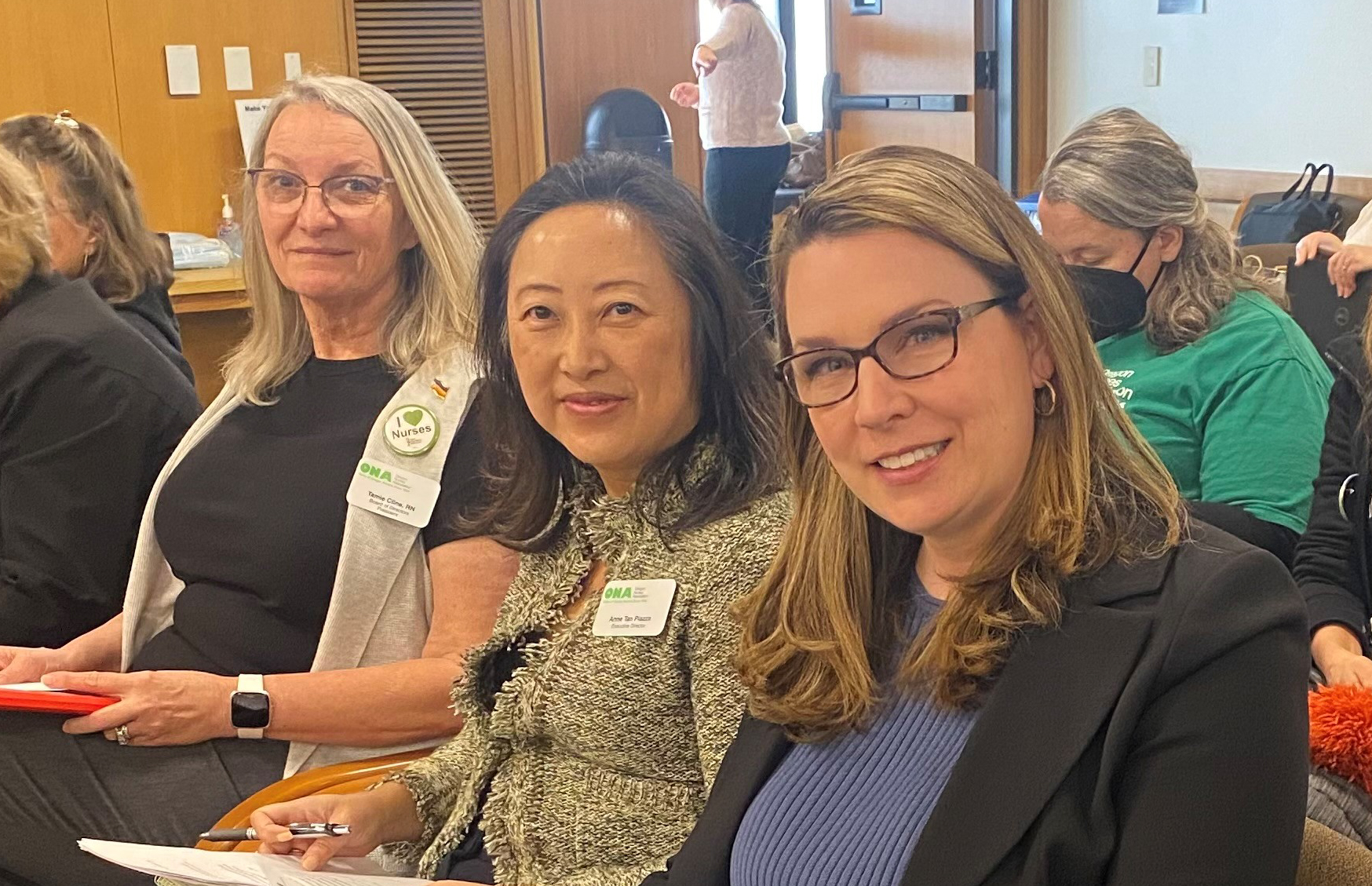
From left to right: ONA President Tamie Cline, ONA Executive Director Anne Tan Piazza, and ANA President Dr. Jennifer Mensik Kennedy pictured at HB 2697 hearing on Jan. 27, 2023.
SALEM, Ore. - Testimony before the Oregon House Committee on Behavioral Health and Health Care on both February 27 and 28, 2023 from nursing and frontline health care leaders and experts from across Oregon and the American Nurses Association
was unequivocal; HB 2697 will improve staffing and patient care, and Oregon has more than enough nurses to meet the common sense, research-tested minimum staffing standards required by the bill.
Tuesday’s public testimony saw overflowing hearing rooms, with hundreds of nurses and health care providers from across the state in attendance; so many, in fact, that not everyone could testify, even though the public testimony period was extended.
More than 400 pieces of written testimony in support of the bill were also submitted.
Dr. Jennifer Mensik Kennedy, PhD, MBA, RN, NEA-BC, FAA, President of the American Nurses Association, testified during the invited hearing on February 27, that “the American Nurses Association supports enforceable, minimum nurse staffing ratios
as a valuable approach to reduce patient harm, improve quality outcomes, and ensure the creation of a healthy work environment. HB 2697 will improve nurse staffing and patient care.”
ONA and OFNHP believe the position taken by Oregon’s hospitals and health care systems that “there aren’t enough nurses to meet these standards” was always based on faulty data. Dr. Kennedy clearly agreed, pointing directly to data from California
(which passed similar staffing standards in 2001).
“There are concerns that there are not enough staff for ratios in Oregon,” Dr. Kennedy testified. “But based on US Bureau of Labor Statistics, August of 2022 data shows that California has 8.1 nurses per 1,000 and Oregon has 8.92 nurses per 1,000
population. This is over 8% more nurses per population than in California.”
Further testimony indicated that Oregon’s current situation, where nurses and other frontline health care workers are chronically understaffed, poses a direct threat to patient health. “Nurses who care for more patients are more likely to experience
medication errors,” said Tamie Cline, RN, President of the Oregon Nurses Association. “We see increased patient mortality, more pressure ulcers, more infections, more cases of pneumonia, longer hospital stays, more hospital re-admissions, more respiratory
failures, and more preventable death.”
These same issues are affecting dozens of classifications that make up the entire care model of the hospitals, including health care professionals like physical therapists, respiratory therapists, and physician’s assistants. “We know that understaffing
affects the entire system of care in a hospital, impacting dozens of positions and creating a nearly unworkable system for those providing care to our communities,” says Jonathon Baker, President of the Oregon Federation of Nurses and Health Professionals
(OFNHP). “The evidence is clear. Setting minimum staffing standards is the necessary first step in solving our staffing crisis and will help to re-establish trust with the health care workers that have been pushed out of the industry by dangerous
conditions.”
HB 2697 also directly addresses another key issue for nurses and frontline health care workers: systemic failures to ensure staff get their legally required rest and meal breaks. “For nurses and allied health care workers, meal and rest breaks are
essential to prevent exhaustion, medication errors, and burnout,” said ONA Executive Director Anne Tan Piazza. “In a 12-hour shift, Oregon law affords workers a 30-minute meal break and three 15-minute rest breaks. We know that nurses are not getting
their breaks. This is not in question. In fact, a recent survey of ONA members indicates that 92% of nurses report missing meal and rest breaks.”
Testimony, research and data all agree: HB 2697 is right for Oregon, will prevent ongoing turnover of crucial health care staff, will encourage those carers that have already left the bedside to return, will alleviate unsafe working conditions for
nurses and other providers, and will help ensure the best outcomes for patients.
ONA and OFNHP, along with our colleagues from the American Nurses Association and the American Federation of Teachers, urge the Oregon Legislature to pass this bill.
More information can be found at www.SafeStaffingSavesLives.com
View the Full Testimony of ONA Executive Director, Anne Tan Piazza
View the Full Testimony of ANA President, Dr. Jennifer Mensik Kennedy
The Oregon Nurses Association (ONA) is the state’s largest and most influential nursing organization. We are a professional association and labor union which represents more than 15,000 nurses and allied health workers throughout the state. ONA’s mission is to advocate for nursing, quality health care and healthy communities. For more information visit:
www.OregonRN.org.








